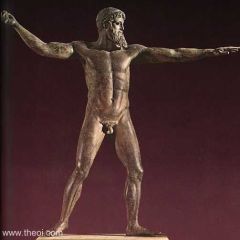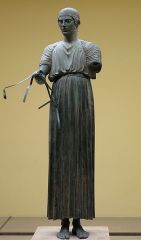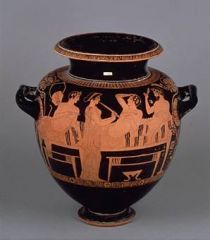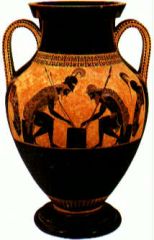![]()
![]()
![]()
Use LEFT and RIGHT arrow keys to navigate between flashcards;
Use UP and DOWN arrow keys to flip the card;
H to show hint;
A reads text to speech;
7 Cards in this Set
- Front
- Back

|
The statue of Laocoön and His Sons, (The Laocoön Group), a monumental sculpture in marble now in the Vatican Museums, Rome. The statue is attributed by the Roman author Pliny the Elder to three sculptors from the island of Rhodes: Agesander, Athenodoros and Polydorus. It shows the Trojan priest Laocoön and his sons Antiphantes and Thymbraeus being strangled by sea serpents.
|
|

|
Aphrodite of Milos (Greek: Αφροδίτη της Μήλου, Aphroditē tēs Mēlou), better known as the Venus de Milo, is an ancient Greek statue and one of the most famous works of ancient Greek sculpture. Created at some time between 130 and 100 BCE, it is believed to depict Aphrodite (Venus to the Romans) the Greek goddess of love and beauty. It is a marble sculpture, slightly larger than life size at 203 cm (6 ft 8 in) high. Its arms and original plinth have been lost. From an inscription that was on its plinth, it is thought to be the work of Alexandros of Antioch; it was earlier mistakenly attributed to the master sculptor Praxiteles. It is at present on display at the Louvre Museum in Paris.
|
|

|
The Winged Victory of Samothrace (the Nike of Samothrace). A 203 BC marble sculpture of the Greek goddess Nike (Victory). It conveys a sense of action and triumph as well as portraying artful flowing drapery through its features which the Greeks considered ideal beauty.
|
|

|
Greek bronze sculpture depicting the god Poseidon. "Poseidon Soter at Artemisium" (c. 575 B.C.).
|
|

|
The Charioteer of Delphi. An ancient bronze statue. The statue was erected at Delphi in 474 BC, to commemorate the victory of a chariot team in the Pythian Games, which were held at Delphi every four years in honor of Pythean Apollo.
|
|

|
Red-figure pottery. A style of figural Greek vase painting. It developed in Athens around 530 BC and remained in use until the late 3rd century BC
|
|

|
Black-figure pottery, a style of ancient Greek pottery painting in which the decoration appears as black silhouettes on a red background. Originating in Corinth during the early 7th century BC, it was introduced into Attica about a generation later. Other notable black-figure potteries existed at Sparta, Athens, and in eastern Greece. The technique flourished until being practically replaced by the more advanced red-figure pottery technique in 530 BC, although later examples do exist.
|

